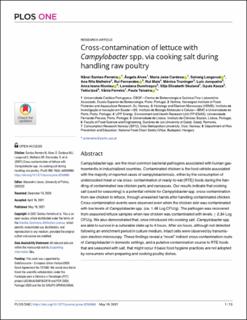| dc.description.abstract | Article Authors Metrics Comments Media Coverage Abstract Introduction Materials and methods Results Discussion Supporting information Acknowledgments References Reader Comments (0) Figures Abstract Campylobacter spp. are the most common bacterial pathogens associated with human gastroenteritis in industrialized countries. Contaminated chicken is the food vehicle associated with the majority of reported cases of campylobacteriosis, either by the consumption of undercooked meat or via cross- contamination of ready-to-eat (RTE) foods during the handling of contaminated raw chicken parts and carcasses. Our results indicate that cooking salt (used for seasoning) is a potential vehicle for Campylobacter spp. cross-contamination from raw chicken to lettuce, through unwashed hands after handling contaminated chicken. Cross-contamination events were observed even when the chicken skin was contaminated with low levels of Campylobacter spp. (ca. 1.48 Log CFU/g). The pathogen was recovered from seasoned lettuce samples when raw chicken was contaminated with levels ≥ 2.34 Log CFU/g. We also demonstrated that, once introduced into cooking salt, Campylobacter spp. are able to survive in a culturable state up to 4 hours. After six hours, although not detected following an enrichment period in culture medium, intact cells were observed by transmission electron microscopy. These findings reveal a “novel” indirect cross-contamination route of Campylobacter in domestic settings, and a putative contamination source to RTE foods that are seasoned with salt, that might occur if basic food hygiene practices are not adopted by consumers when preparing and cooking poultry dishes. | |
